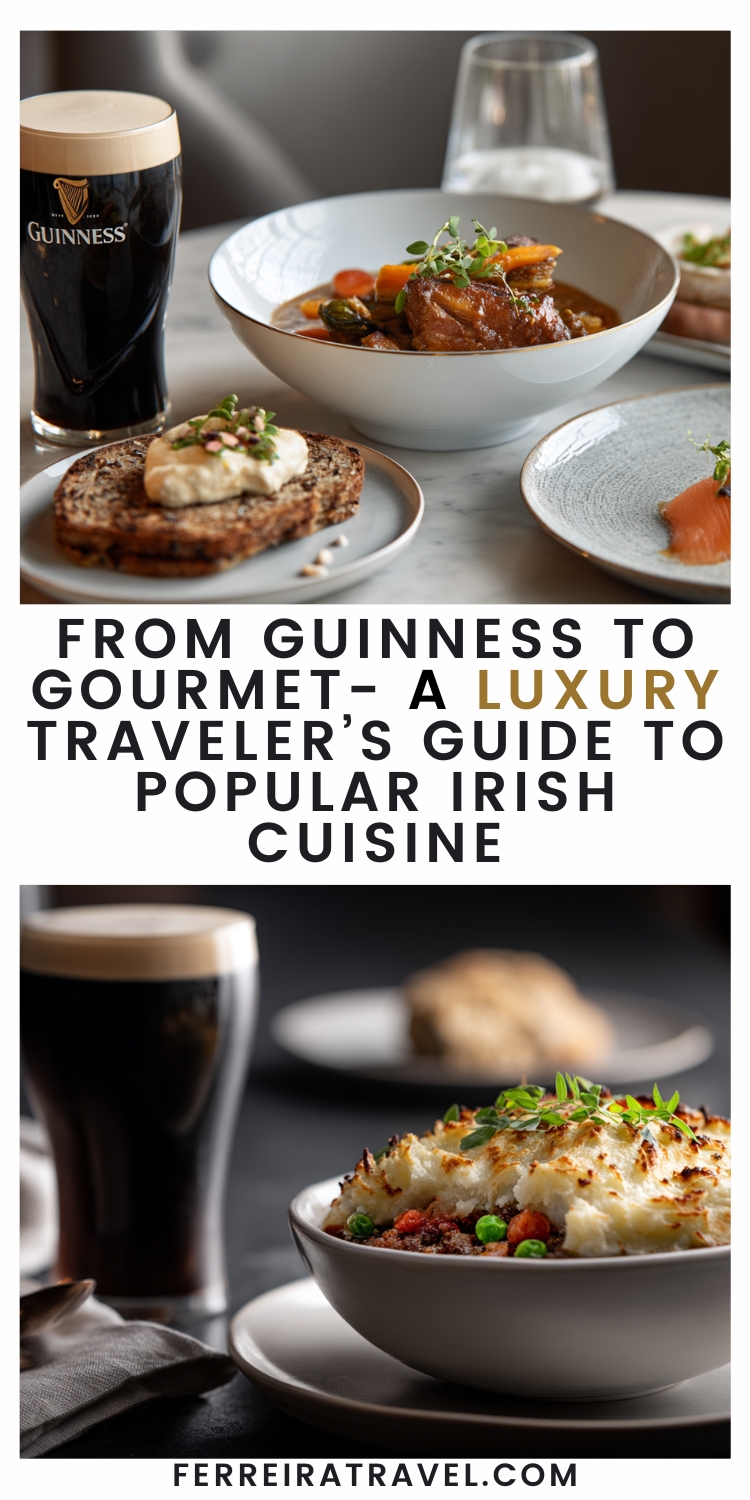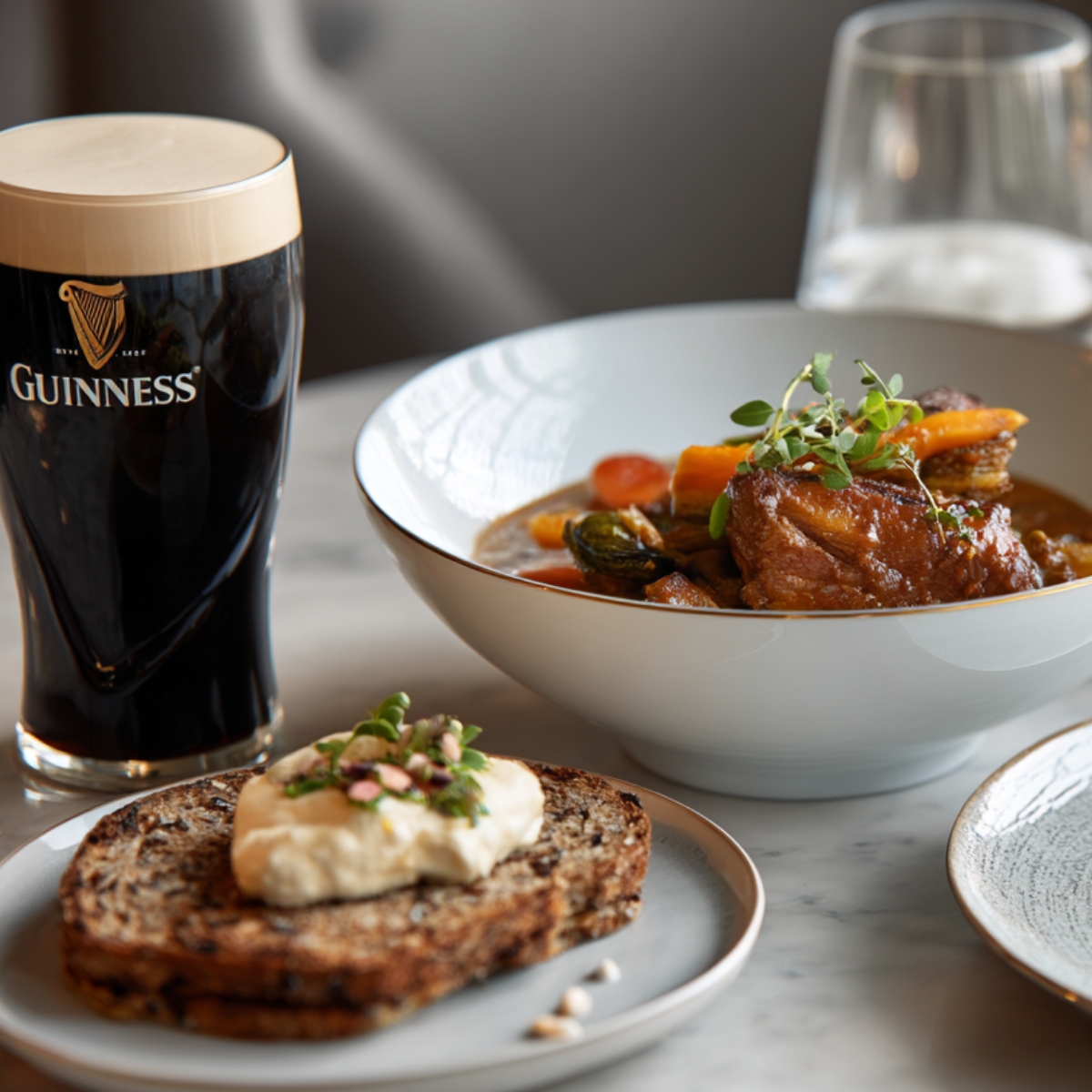From Guinness to Gourmet: A Luxury Traveler’s Guide to Popular Irish Cuisine
Please note that this article may contain affiliate links. As an Amazon Associate, I earn on qualifying purchases at no additional cost to you. You can read more at the bottom of this page or read my full disclosure on my Affiliate Disclosure Page
Irish food has long been celebrated for comfort and simplicity, but luxury travelers know there’s far more hiding behind the pub doors and along the Atlantic coast. Popular Irish cuisine is rich, filling, and made to be shared, yet it has also stepped confidently into the world of fine dining. Whether you’re eyeing a Michelin-starred table in Dublin or sampling oysters fresh from Galway Bay, Ireland is ready to surprise you at every course.

What Defines Popular Irish Cuisine?
Irish cuisine is shaped by a handful of traits: it’s hearty, seasonal, and born from the land. Think lamb grazing on green hills, potatoes harvested from fertile soils, and butter so rich it could carry a meal on its own. While rustic flavors still anchor Irish food, chefs now reinterpret these staples with flair.
- Farm-to-table menus highlight local dairies and organic gardens.
- Traditional stews appear with heritage meats and wine reductions.
- Simple breads are transformed into gourmet pairings with infused butters.
This balance of heritage and innovation means you don’t just eat in Ireland, you experience history plated with creativity.
What Are the Hearty Classics of Irish Cuisine?
Irish Stew
This dish is practically a national treasure, and it is one of my absolutel favorites when in Ireland (especially Guinness stew!) Traditionally it’s made with lamb, potatoes, onions, and carrots simmered until tender, it’s the kind of meal that warms from the inside out. Today, you’ll find chefs elevating it with slow-braised shanks, pearl onions, or even a wine-based broth.
Dublin Coddle
Picture sausages, bacon, and potatoes layered together and left to cook gently. Originally, it was the Dublin answer to leftovers. In upscale kitchens, it’s reimagined with artisanal sausages and heirloom vegetables.
Shepherd’s Pie and Cottage Pie
Shepherd’s pie features lamb, while cottage pie uses beef. Either way, it’s topped with creamy mash that can be piped like pastry for a refined twist. Expect to see it at countryside inns served alongside wine lists that rival city restaurants.
Which Breads and Potato Dishes Are Most Popular?
Soda Bread
A few simple ingredients—flour, salt, baking soda, buttermilk—create this iconic loaf. In luxury hotels, it often arrives warm with honey butter or seaweed-infused spreads.
Boxty
Ireland’s version of a potato pancake. Crispy on the outside, soft inside, and often topped with smoked salmon and crème fraîche at gourmet eateries.
Colcannon and Champ
These mashed potato variations fold in cabbage, kale, or scallions. On fine dining menus, they’re dressed with garlic butter or upgraded with truffles.
How Does the Coast Shape the Most Popular Irish Cuisine?
Seafood Chowder
Creamy, hearty, and brimming with fresh fish. The seaside town of Kinsale is famous for chowder festivals, but high-end restaurants now turn this classic into artful bowls paired with Sauvignon Blanc.
Smoked Salmon and Oysters
Ireland’s Atlantic coast delivers world-class seafood. Travelers can tour smokehouses or attend oyster festivals, sampling the freshest catches in elegant settings.
Dublin Lawyer
No… not that kind of lawyer! This is Lobster cooked in whiskey and cream… luxury with a wink. Expect to see this on menus at Dublin’s finest restaurants.
What Irish Desserts Should Luxury Travelers Try?
Barmbrack
A fruit-studded loaf once tied to Halloween traditions. Modern bakeries glaze it and serve it with spiced tea or dessert wine.
Apple Cake with Custard
A farmhouse favorite that now shows up with Chantilly cream or caramel drizzle at high-end cafés.
Guinness Chocolate Cake and Irish Coffee
Absolute proof that stout belongs in dessert. Pair it with a perfectly layered Irish coffee in a hotel bar where harp music sets the scene. This is complete perfection.
What Luxury Food Experiences Can I Arrange For You in Ireland?
This is where travel planning elevates your trip. I can connect you to exclusive tours that take food beyond the table:
- Private whiskey tastings with distillers who share secrets not found on the public tour.
- Market visits with local guides who lead you to hidden vendors and behind-the-counter tastings.
- Cooking classes where you try your hand at making boxty or brown bread under the eye of a skilled Irish chef or in the home of a local.
- Coastal excursions that start at the docks and end with seafood prepared just steps from where it was caught.
- Farm-to-table evenings at estates where every dish tells the story of the land.
These experiences are designed to give you insider access to popular Irish cuisine while surrounding you with comfort and care.
Why Add Ireland to Your Culinary Bucket List?
Popular Irish cuisine has grown from rustic sustenance into gourmet artistry. You can sip Guinness in a village pub, then enjoy lobster in whiskey cream at a Michelin-starred restaurant. With carefully curated tours, you’re not just eating the best meals, you’re weaving them right into your travel story.
When you’re ready to taste the Ireland that most visitors miss, I can arrange the food-focused journey of a lifetime. Every bite tells a story, and every glass raised will remind you that Ireland is where tradition and luxury finally meet.
FAQs About Popular Irish Cuisine
-
What is the difference between Irish stew and Dublin coddle?
Irish stew is lamb-based, with vegetables simmered in broth. Dublin coddle uses sausages and bacon, layered with potatoes and onions. Both are quintessential, but very different in flavor.
-
How is an Irish breakfast different from an English breakfast?
The Irish breakfast includes black and white pudding, while the English version leans more on baked beans. The Irish plate is richer, heartier, and best enjoyed with strong tea.
-
When is the best time of year to try Irish food?
-Autumn and winter for stews and pies
-Spring for oysters and fresh seafood
-Summer festivals for outdoor food events

